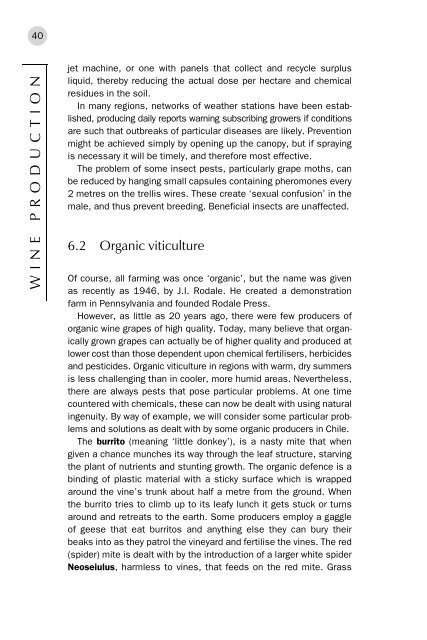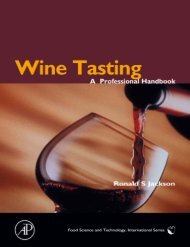Wine Production : Vine to Bottle - Vinum Vine
Wine Production : Vine to Bottle - Vinum Vine
Wine Production : Vine to Bottle - Vinum Vine
Create successful ePaper yourself
Turn your PDF publications into a flip-book with our unique Google optimized e-Paper software.
40<br />
WINE PRODUCTION<br />
jet machine, or one with panels that collect and recycle surplus<br />
liquid, thereby reducing the actual dose per hectare and chemical<br />
residues in the soil.<br />
In many regions, networks of weather stations have been established,<br />
producing daily reports warning subscribing growers if conditions<br />
are such that outbreaks of particular diseases are likely. Prevention<br />
might be achieved simply by opening up the canopy, but if spraying<br />
is necessary it will be timely, and therefore most effective.<br />
The problem of some insect pests, particularly grape moths, can<br />
be reduced by hanging small capsules containing pheromones every<br />
2 metres on the trellis wires. These create ‘sexual confusion’ in the<br />
male, and thus prevent breeding. Beneficial insects are unaffected.<br />
6.2 Organic viticulture<br />
Of course, all farming was once ‘organic’, but the name was given<br />
as recently as 1946, by J.I. Rodale. He created a demonstration<br />
farm in Pennsylvania and founded Rodale Press.<br />
However, as little as 20 years ago, there were few producers of<br />
organic wine grapes of high quality. Today, many believe that organically<br />
grown grapes can actually be of higher quality and produced at<br />
lower cost than those dependent upon chemical fertilisers, herbicides<br />
and pesticides. Organic viticulture in regions with warm, dry summers<br />
is less challenging than in cooler, more humid areas. Nevertheless,<br />
there are always pests that pose particular problems. At one time<br />
countered with chemicals, these can now be dealt with using natural<br />
ingenuity. By way of example, we will consider some particular problems<br />
and solutions as dealt with by some organic producers in Chile.<br />
The burri<strong>to</strong> (meaning ‘little donkey’), is a nasty mite that when<br />
given a chance munches its way through the leaf structure, starving<br />
the plant of nutrients and stunting growth. The organic defence is a<br />
binding of plastic material with a sticky surface which is wrapped<br />
around the vine’s trunk about half a metre from the ground. When<br />
the burri<strong>to</strong> tries <strong>to</strong> climb up <strong>to</strong> its leafy lunch it gets stuck or turns<br />
around and retreats <strong>to</strong> the earth. Some producers employ a gaggle<br />
of geese that eat burri<strong>to</strong>s and anything else they can bury their<br />
beaks in<strong>to</strong> as they patrol the vineyard and fertilise the vines. The red<br />
(spider) mite is dealt with by the introduction of a larger white spider<br />
Neoseiulus, harmless <strong>to</strong> vines, that feeds on the red mite. Grass
















